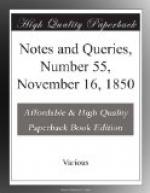T.D.
Bath.
“Thompson of Esholt” (Vol. ii., p. 268.).—In an old pedigree of the Calverley family, I find it stated that Henry Thompson of Esholt (whose only daughter Frances William Calverley of Calverley married, and by her acquired that property) was great-grandson to Henry Thompson,
“One of the king’s gentlemen-at-arms at the siege of Boulogne (temp. H. 7.), where he notably signalised himself, and for his service was rewarded with the Maison Dieu at Dover, by gift of the king; afterwards, in the reign of Edward VI., exchanged it for the manor and rectory of Bromfield in Cumberland, and the site of the late dissolved nunnery of Esholt.”
Further particulars regarding the above grant of Bromefield, and a pedigree of the Thompsons, are published in Archaeologia Oeliana, vol. ii. (1832), p. 171.
W.C. TREVELYAN.
Wallington.
Minar’s Book of Antiquities (Vol. i., p. 277.; ii. p. 344.).—I am much obliged to T.J. for his endeavours to help me to Minar’s Book of Antiquities. But there still remains a chasm too wide for me to jump; inasmuch as Christopher Meiners published his treatise De Vero Deo in 1780, and Cardinal Cusa, who refers to Minar, died in 1464, being more than 300 years before.
A.N.
Croziers and Pastoral Staves (Vol. ii., pp. 248, 313.).—The opinion expressed by the REV. MR. WALCOT (in your No. 50.), that by the word crozier is to be understood the crossed staff belonging only to archbishops and legates, while the staff with a crook at its end is to be called the pastoral staff, cannot, I think, be considered satisfactory, for the following, among other reasons.
Crozier is generally (I should formerly have said universally) understood to mean the staff with a crook, the so well-known “ensign of bishops.”
In the instances mentioned by MR. WALCOT, croziers are repeatedly spoken of as having been borne at the funerals of bishops, while the crosses borne before Wolsey are called crosses, and not croziers.
The word crozier seems to be derived from the mediaeval Latin word crocia. This is explained by Ducange: “Pedum, baculus pastoralis, episcopalis.” Crocia seems to be derived from, or closely connected with, “crocha, uncinus, lamus,” and “crochum, uncus quo arcubalistae tenduntur” (Ducange). Hence it appears that crozier does not refer to a cross but to a crook.
In such ancient authorities as I have had the opportunity of referring to at the moment, as brasses, incised slabs, &c., bishops and archbishops are alike represented with the crooked staff; a cross is of more rare occurrence, and at the moment only two instances occur to me, one in the fine brass of Frederic, son of Casimir, king of Poland, and a cardinal, which is in the cathedral of Cracow, and in which he is represented holding a crozier, while crosses are figured on the sides under the cardinal’s hat. The other is in the curious brass of Lambert, bishop of Bamberg, in the cathedral of that city: in this the bishop holds a cross in his right and a crozier in his left hand.




